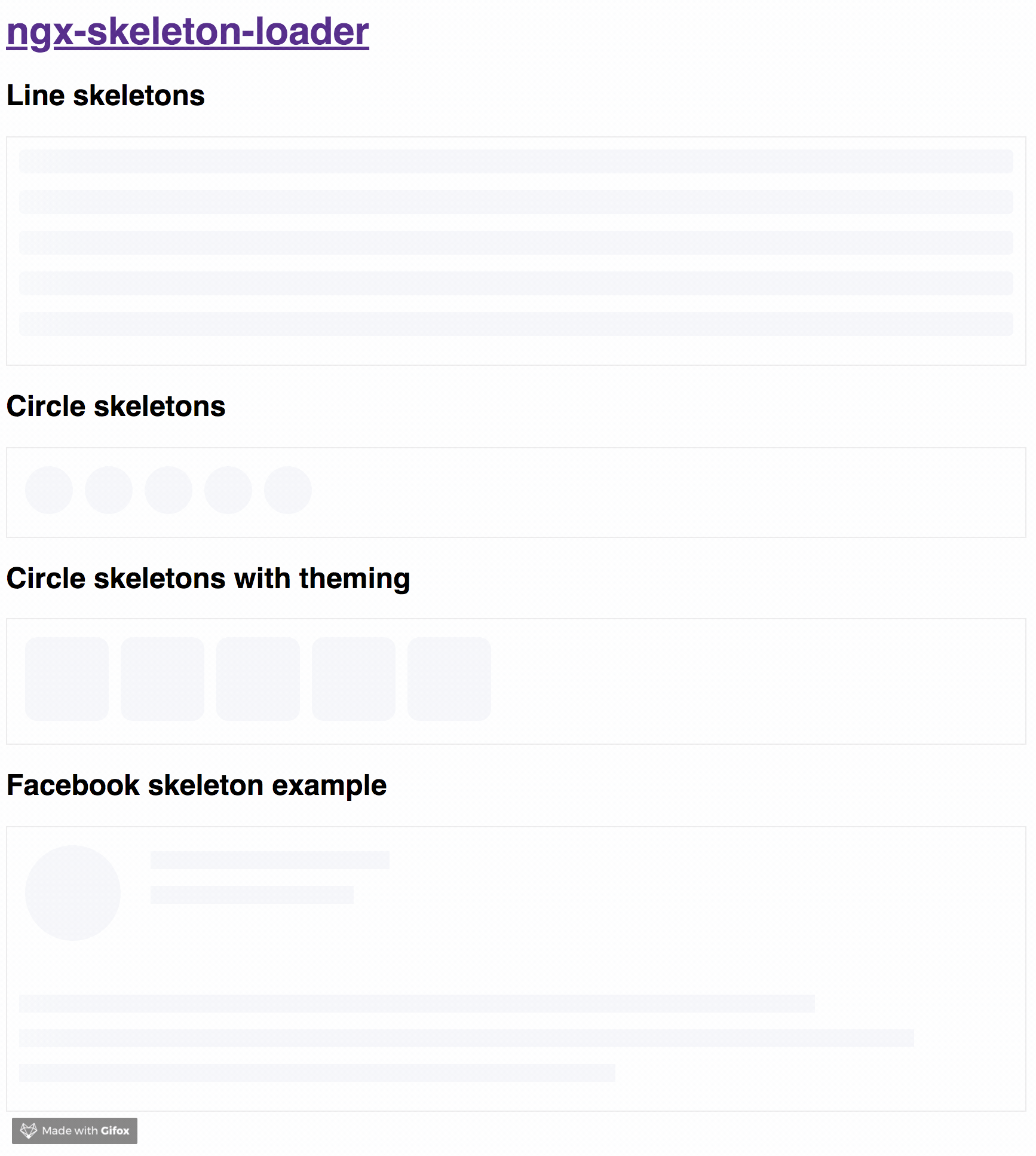NGX Skeleton loader










Why skeletons?
If you want to get more details about that, please read "NGX-Skeleton-Loader — States, Animations, Performance, and Accessibility for your Angular App" blog post
The idea of this component is make the process transparent and easier. So the main point is integrate this component with other tooling process, such as:
- Server-side rendering;
- Progressive rendering;
- Any other that you like :)
It's totally transparent for you and you can integrate easier in your application, improving your user experience 🎉
Demo
Try out our demos on Stackblitz!
Install
You can get it on NPM installing ngx-skeleton-loader module as a project dependency.
npm install ngx-skeleton-loader --save
Setup
You'll need to add NgxSkeletonLoaderModule to your application module. So that, the <ngx-skeleton-loader> components will be accessible in your application.
...
import { NgxSkeletonLoaderModule } from 'ngx-skeleton-loader';
...
@NgModule({
declarations: [
YourAppComponent
],
imports: [
...
NgxSkeletonLoaderModule,
...
],
providers: [],
bootstrap: [YourAppComponent]
})
export class YourAppComponent {}
After that, you can use the ngx-skeleton-loader components in your templates, passing the configuration data into the component itself.
ngx-skeleton-loader: Handle the skeleton animation and the skeleton styles of your app;
<div class="item">
<ngx-skeleton-loader count="5" appearance="circle"></ngx-skeleton-loader>
</div>
Using NgxSkeletonLoaderModule.forRoot()
Also, you can import the module in your app by calling NgxSkeletonLoaderModule.forRoot() when adding it. So it will be available across your Angular application.
Importing the module this way also allows you to globally configure the default values for the ngx-skeleton-loader components in your application, in case you need some different default values for your app.
...
import { NgxSkeletonLoaderModule } from 'ngx-skeleton-loader';
...
@NgModule({
declarations: [
YourAppComponent
],
imports: [
...
NgxSkeletonLoaderModule.forRoot({ animation: 'pulse', loadingText: 'This item is actually loading...' }),
...
],
providers: [],
bootstrap: [YourAppComponent]
})
export class YourAppComponent {}
<div class="item">
<ngx-skeleton-loader count="5" appearance="circle"></ngx-skeleton-loader>
</div>
WAI-ARIA values
- loadingText - default
Loading...: attribute that defines the text value for aria-valuetext attribute. Defaults to "Loading..." aria-label - default loading: you can add ariaLabel as input of the component to set a different value.
Appearance
You can also define which appearance want to use in your skeleton loader by passing the options in your component via [appearance] attribute.
Options
'' - default: it will use it '' as appearance. At the end, it will render like a line;line: it will render like a line. This is the same behavior as passing an empty string;circle: it will use circle as appearance. Great for avatar skeletons, for example :);
Animations
You can also define which CSS animation you want to use - even not use any, if it's the case - in your skeleton loader by passing the options in your component via [animation] attribute.
Options
"false" (as string): it will disable the animation;false (as boolean): it will disable the animation. Animation will receive false as string when attribute field it's not using binding. Component now can receive false (boolean), "false" (string), or any other animation type via binding;progress - default: it will use it progress as animation;progress-dark: it will use it progress-dark as animation. Recommended if your color schema is darken;pulse: it will use pulse as animation;
progress is the default animation, used as the single one previously. If you don't pass the animation attribute, it defaults to progress.
<div class="item">
<ngx-skeleton-loader animation="false"></ngx-skeleton-loader>
<ngx-skeleton-loader [animation]="classAttributeWithBooleanFalseValue"></ngx-skeleton-loader>
<ngx-skeleton-loader animation="progress"></ngx-skeleton-loader>
<ngx-skeleton-loader></ngx-skeleton-loader>
<ngx-skeleton-loader animation="pulse"></ngx-skeleton-loader>
</div>
You can check the code details in the Stackblitz Live Demo Link
Theming
You can also define different styles for the skeleton loader by passing an object with the css styles - in dashed case - into the component via [theme] attribute.
<div style="background: #FF0001; padding: 10px;">
<ngx-skeleton-loader
count="5"
[theme]="{
'border-radius': '5px',
height: '50px',
'background-color': '#992929',
border: '1px solid white'
}"
></ngx-skeleton-loader>
</div>
The [theme] attribute now accepts the same configuration as ngStyle as well. That means you can manage to use like you're doing with the built-in directive, having a pleasure and beautiful experience
<div style="background: #FF0001; padding: 10px;">
<ngx-skeleton-loader
count="5"
[theme]="{
'height.px': 50,
'background-color': '#992929'
}"
></ngx-skeleton-loader>
</div>
⚠️ This is here only as a documentation, but it's not encouraged to be used. Please consider use it with caution ⚠️
Also, you can use CSS to add theme styles into your component. However, there are some implications:
- You're using
:host in your stylesheet, which means you are aware of any possible problem :host can create for your app at that level since it's based on :host DOM style scoping - You're adding stylesheet based on
<ngx-skeleton-loader> internal classes. It means that class naming changes on module's side will be breaking changes for your application as well.
As an example, your Component file is like this
import { Component } from '@angular/core';
@Component({
selector: 'my-ngx-skeleton-loader-with-theming',
templateUrl: './my-ngx-skeleton-loader-with-theming.component.html',
styleUrls: ['./my-ngx-skeleton-loader-with-theming.component.css'],
})
export class MyNGXSkeletonLoaderWithThemingComponent {
}
And your component HTML code is
<ngx-skeleton-loader count="5" animation="pulse"></ngx-skeleton-loader>
You can apply theme changes in our stylesheet. At the end it will be
:host >>> ngx-skeleton-loader .loader {
border-radius: 5px;
height: 50px;
background-color: #992929;
border: 1px solid white;
}
You should change the styles on the skeleton wrapper element in case you need to change the background color. You can check the code details in the Stackblitz Live Demo Link or check it out a content load simulation in this Stackblitz Live Demo Link
Development
Run demo locally
- This project uses Angular CLI as base. That means you just need to run
npm start and access the link http://localhost:4200 in your browser
Run tests
- Run
npm test for run tests. In case you want to test using watch, please use npm run tdd
Publish
this project is using np package to publish, which makes things straightforward. EX: np <patch|minor|major> --contents=dist/ngx-skeleton-loader
For more details, please check np package on npmjs.com
Contribute
For any type of contribution, please follow the instructions in CONTRIBUTING.md and read CODE_OF_CONDUCT.md files.
Author
Wilson Mendes (willmendesneto)










